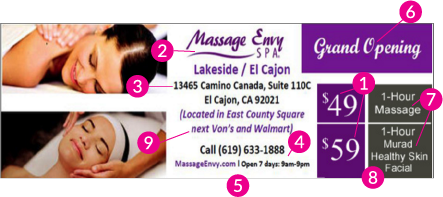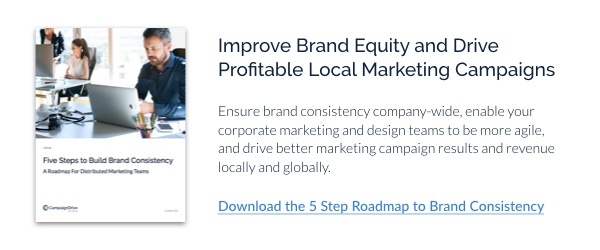Every local marketer knows (or at least claims to agree!) that consistent marketing execution (also known as brand compliance) is key to leveraging the value of the brand. But when you’re trying to get a promotion out the door, it’s easy to forget that even the smallest nuance of design adds to or subtracts from brand equity.
When there are hundreds of franchisees, dealers or retailers producing marketing materials all around the country, how can brand managers ensure all of those promotions are brand-compliant? The best way to achieve brand compliance is with the process they create for their local marketers. For these marketing leaders, the devil really is in the details.
The Brand Compliance Disconnect
When local marketers hear that they've broken the brand's design rules, they're usually shocked. They think they’ve tried to be good “brand citizens” all along the way and think the marketing they've produced really looks and feels like a professional piece. But all too often, local marketers' best intentions don't translate into the consistent branded executions that franchise and dealer brands depend on to build brand trust with customers.
Take a look at the coupon examples below for the Massage Envy brand (not a CampaignDrive by Pica9 customer, but one that we've always admired) to get a sense of how this kind of disconnect can happen.
| A brand-executed coupon (we assume designed by a graphic artist at headquarters in compliance with brand standards) |
A locally-executed coupon (probably designed by a freelance artist or newspaper production department for a California franchisee) |
 |
 |
At first glance, the designer of the local coupon seems to be eager to leverage the Massage Envy brand. The use of the purple brand color, brand photography, and the prominent placement of the brand logo all seem to indicate that the creator was keen on complying with the brand standards.
But take a minute to look more closely at the two executions. Assuming that the brand-executed coupon is indeed 100% compliant with brand standards, see how many deviations from brand-standard you can find in the locally-executed coupon on the right. In less than a minute’s time, we found nine.
-
Price is in a non-standard typeface
-
A closer look at the local coupon reveals a number of design choices that are not brand-compliant.
 Insufficient “air” (space on top and bottom) around the corporate logo
Insufficient “air” (space on top and bottom) around the corporate logo - Non-standard typeface for location listing
- Non-standard blending of purple and black type
- No legal disclaimer
- Non-standard typeface for Grand Opening
- Non-standard font for massage packages
- Non-standard gray background color
- Grammatical error in location descriptor
Looked at from the local marketer’s perspective, the local coupon is a faithful, well-intentioned effort to produce a brand-compliant promotion. But seen through the eyes of the brand, the coupon has to be judged non-compliant. In some areas, like the non-standard mixing of purple and black, the differences are minor. In other areas, though, these off-brand elements create problems that could have serious consequences. For instance, the missing legal disclaimers in the local promotion could open up the brand to lawsuits.
What’s worse, the non-standard elements don’t do anything to add to the selling power of the coupon. The standards are broken, really, for no good reason at all. More likely than not, the local marketer, lacking a brand designer’s eye, just didn’t see the differences as important — or perhaps, didn’t really see the differences at all.
Don’t Just Enforce Brand Guidelines — Activate Them
By providing users with marketing templates that automatically activate brand guidelines, a modern brand management system can address all of the problems we just reviewed, without (A) forcing brand designers to produce each and every local execution (which is unsustainable), or (B) handcuffing local marketers to brand-approved promotions only (which is infuriating).
Here are just a few of the common issues that a brand asset management system can address.
- Prevent the use of non-standard typefaces and colors. A well designed local marketing template will confine users to a brand-defined palette of colors and a brand-approved (and properly licensed) set of brand fonts. If well-designed, the system will allow for the automatic scaling of type within parameters set by the brand, so local marketers can balance their need for content with the over-arching requirement for brand consistency.
- Require the use of brand-approved legal disclaimers and disclosure. Today’s local marketing systems can be configured to apply legal disclaimers and disclosures automatically, based on the type of offer a local marketer wishes to include.
- Prevent non-compliant executions of brand logos and elements. Most local marketers don’t understand why critical brand elements require very specific design constraints. But with a modern local marketing automation system, they don’t need to understand the design logic behind these critical rules — because the system ensures compliance automatically for them.
- Require the use of pre-approved (grammatically correct) content. In our experience, local marketers initially believe they want the freedom to write their own advertising and marketing copy from scratch. But more often than not (far more often, actually), they want to start with a brand suggestion and then to make modest adjustments from there. For brand-marketers, that creates a great opportunity to provide suggested copy for everything from product descriptions to location listings — and thereby attain a higher degree of quality in local executions, while actually requiring less effort from the local marketer.
In short, a modern, well-designed brand management system can help you to make true brand compliance the fastest, easiest way for local marketers to get their promotions out the door. It makes marketing safe, reliable, and even fun—and it saves brand designers hundreds, even thousands, of hours per year.
CampaignDrive by Pica9 is a distributed brand management platform that allows multi-located businesses access customizable, brand compliant material at the local level.






